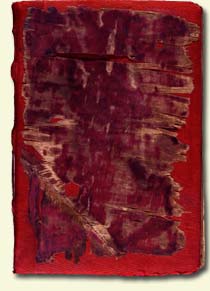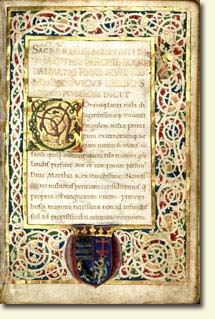Size
The codex is 5.04 inches wide (128mm) and 7.24 inches long (184mm). For comparison, the size of this codex is a little smaller than an iPad mini.
Binding
The binding of the codex includes red silk and matches the practices of codices in the 15th century. In this time period a parchment codex would consist of sewn together folios. A folio is a single leaf of parchment that contains two sides, recto and verso. These sewn-together folios would then be bound to wood boards as covers to the codex.

Writing Support Material
This manuscript was written on parchment. Despite paper being available as a writing support in Western Europe from the 14th century parchment was still widely used for manuscripts and codices.
Collation
The manuscript contains 40 folios and 80 pages. The high-resolution scans of the manuscript show evidence of the rulings used to ensure the writing is straight and neat. Prickings, or small holes made in the parchment to create rule lines for writing straight, can been seen in the corners of pages (e.g. 4r.
Ink
Black ink could have been created using carbon or charcoal combined with gum and water. Another way to make black ink used iron-galls (also called oak-galls) which are abnormal growths on trees where an insect lays its eggs. These galls were mixed with liquids and metal salts to turn the ink black. An early fifteenth-century manuscript from Italy includes a recipe for making black ink (Clemens and Graham, 2007; See also Newberry Library MS 25).
Rubrication and Historiated Initials
Ape. The first and fourth rectos (1r, 4r) provide examples of illuminated historiated initials decorated with gold-colored ink. Examples of rubricaction can be found throughout the manuscript to highlight the dialogue between Ludovicus Carbo (Ludo.) and Zsigmond Ernuszt (Sig.). Recto 4 (4r) also contains text highlighted by red ink that introduces the dialogue between Carbo and Zsigmond. The use of black or a dark colored ink contrasted with red is used throughout the codex and aligns with the Gothic time period for this manuscript’s construction.
Decoration
Rectos 1 and 4 (1r, 4r) contain elaborate decorations. The first recto surrounds the main text with an illuminated white vine stem pattern. Gold-colored ink is used on these two pages. Because using precious metals in ink was a costly process it would have been used in this codex to show the high importance and value attributed to the codex’s subject, King Matthias. The first recto also includes a coat of arms symbol for King Matthias. The coat of arms symbol used in the manuscript matches the coat of arms symbol used on coinage at the time the manuscript was created. The fourth verso contains similar style decoration along the left side forming an “E” shape.

